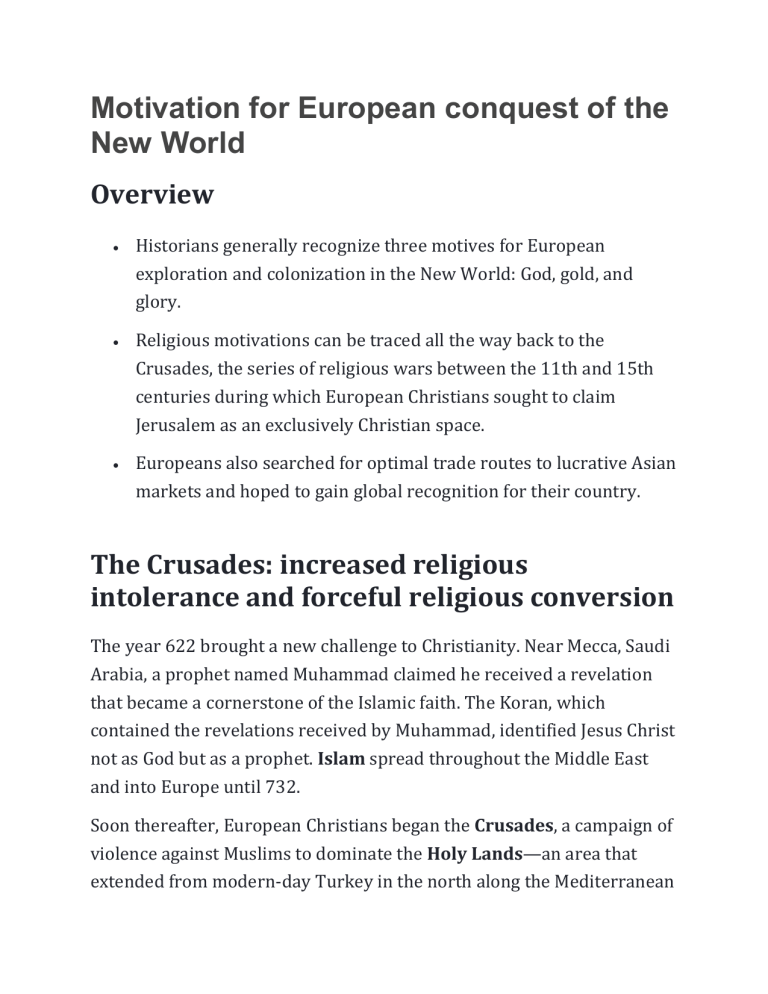
Motivation for European conquest of the New World Overview Historians generally recognize three motives for European exploration and colonization in the New World: God, gold, and glory. Religious motivations can be traced all the way back to the Crusades, the series of religious wars between the 11th and 15th centuries during which European Christians sought to claim Jerusalem as an exclusively Christian space. Europeans also searched for optimal trade routes to lucrative Asian markets and hoped to gain global recognition for their country. The Crusades: increased religious intolerance and forceful religious conversion The year 622 brought a new challenge to Christianity. Near Mecca, Saudi Arabia, a prophet named Muhammad claimed he received a revelation that became a cornerstone of the Islamic faith. The Koran, which contained the revelations received by Muhammad, identified Jesus Christ not as God but as a prophet. Islam spread throughout the Middle East and into Europe until 732. Soon thereafter, European Christians began the Crusades, a campaign of violence against Muslims to dominate the Holy Lands—an area that extended from modern-day Turkey in the north along the Mediterranean coast to the Sinai Peninsula—under Islamic control, partially in response to sustained Muslim control in Europe. The city of Jerusalem is a holy site for Jews, Christians, and Muslims; evidence exists that the three religions lived there in harmony for centuries. But in 1095, European Christians decided not only to reclaim the holy city from Muslim rulers but also to conquer the entire surrounding area. The Crusades provided the religious ideology for the Reconquista, which in turn inspired Atlantic colonization. The Reconquista, or reconquest, refers to the 800 years of violence and expulsion of Muslims from the Iberian Peninsula after the failed Crusades. The Crusades and the Reconquista cemented religious intolerance, and the Christians looked to colonization partly as a means of continuing religious conquests. Particularly in the strongly Catholic nations of Spain and Portugal, religious zeal motivated the rulers to convert Native Americans and sanctify Christian global dominance. Violence in Jerusalem during the Crusades. Image credit: Wikimedia Commons The lure of gold: finding new routes to trade Eastern goods Despite the consequent religious polarization, the Crusades dramatically increased maritime trade between the East and West. As Crusaders experienced the feel of silk, the taste of spices, and the utility of porcelain, desire for these products created new markets for merchants. Merchants’ ships brought Europeans valuable goods, traveling between the port cities of western Europe and the East from the 10th century on along routes collectively labeled the Silk Road. However, transporting goods along the Silk Road was costly, slow, and unprofitable. Muslim middlemen collected taxes as the goods changed hands. Robbers waited to ambush treasure-laden caravans. As well as seeking a water passage to the wealthy cities of the East, sailors wanted to find a route to the exotic and wealthy Spice Islands in modern-day Indonesia, whose location was kept secret by Muslim rulers. The lure of profit pushed explorers to seek new trade routes to the Spice Islands and to eliminate Muslim middlemen. A map of the land trade route from Europe to Asia along the Silk Road. Image credit: A thirst for glory: European competition for global dominance Competition between the Portuguese and the Spanish motivated both nations to colonize quickly and aggressively. Prince Henry the Navigator spearheaded Portugal’s exploration of Africa and the Atlantic in the 1400s. Portuguese sailors successfully navigated an eastward route to West Africa, where they established a trading foothold. Portugal then spread its empire down the western coast of Africa to the Congo, along the western coast of India, and eventually to Brazil and the Atlantic islands. Although the Portuguese did not rule over an immense landmass, their strategic holdings of islands and coastal ports gave them almost unrivaled control of nautical trade routes. Henry the Navigator. The travels of Portuguese traders to western Africa also acquainted the Portuguese with the African slave trade, already widely in practice in West Africa and funded by sugar production on the newly colonized Atlantic islands. Upon discovering the immense global market for sugar, the Portuguese began to trade enslaved people across the Atlantic to toil on the sugar plantations. The Portuguese fort Elmina Castle, located in modern-day Ghana, became more of a holding pen for enslaved Africans from the interior of the continent than a trading post, as the markets for slave labor in both Europe and then the New World boomed. Portuguese colonization in the 1400s inaugurated an era of aggressive European expansion across the Atlantic. The Spanish, threatened by the Portuguese monopoly on enslaved Africans and expansion in the Atlantic, started their own colonization project with Christopher Columbus in 1492. The competition between the two nations continued and drew more and more Europeans to the New World. Christopher Columbus. Image credit: Wikimedia Commons What do you think? How did the Crusades influence European colonization projects? Explain the relationship between religion, commerce, and conquest at the beginning of European exploration and colonization. Imagine you are a European explorer in the 1400s. Do you think you would be most motivated by religious conversion, global market opportunities, or competition with other European nations? Why?


